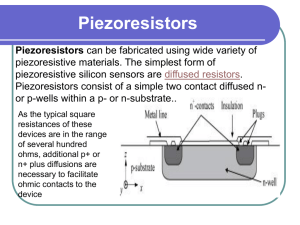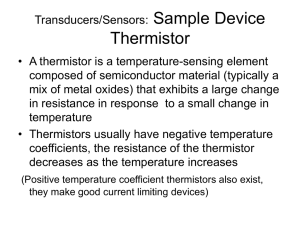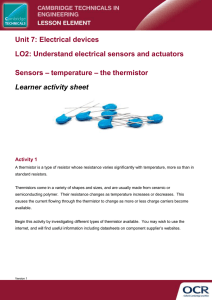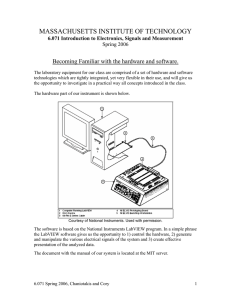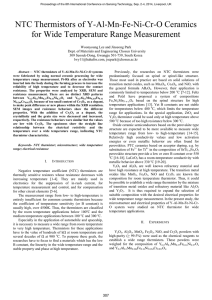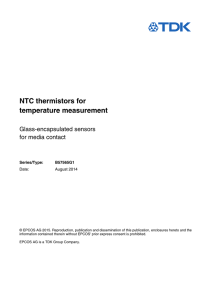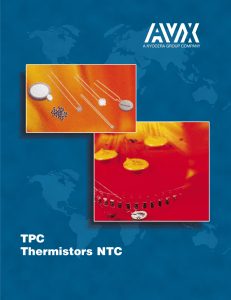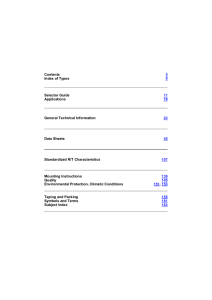NTC thermistor temperature sensors R ∞⋅e Rt=R25⋅e
advertisement
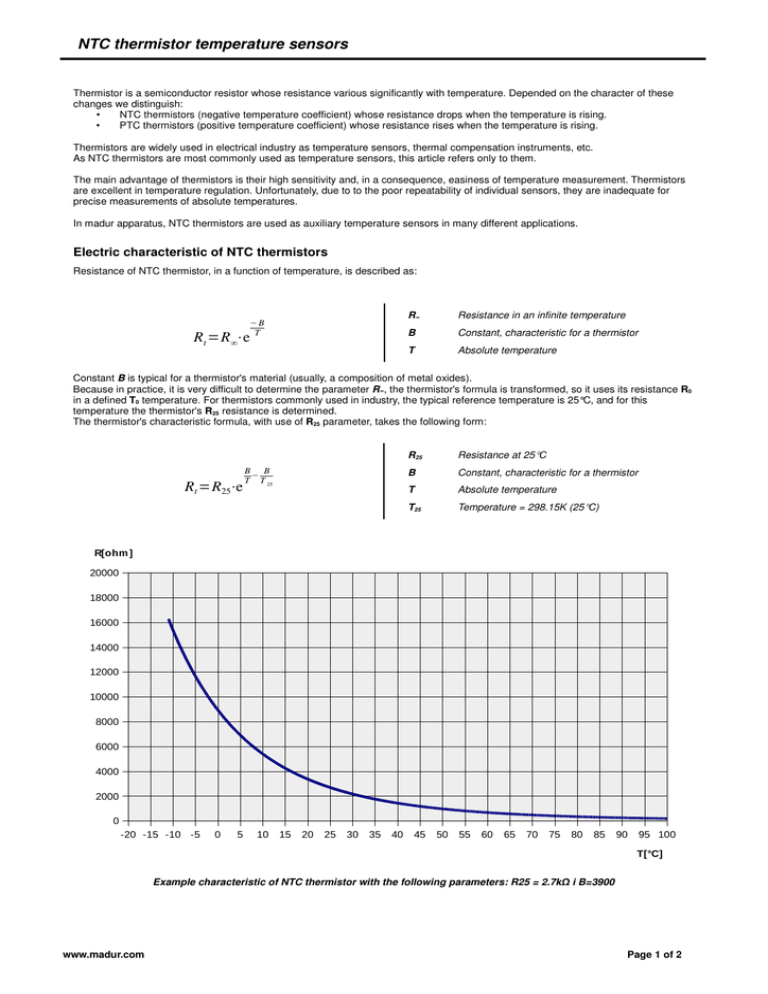
NTC thermistor temperature sensors Thermistor is a semiconductor resistor whose resistance various significantly with temperature. Depended on the character of these changes we distinguish: • NTC thermistors (negative temperature coefficient) whose resistance drops when the temperature is rising. • PTC thermistors (positive temperature coefficient) whose resistance rises when the temperature is rising. Thermistors are widely used in electrical industry as temperature sensors, thermal compensation instruments, etc. As NTC thermistors are most commonly used as temperature sensors, this article refers only to them. The main advantage of thermistors is their high sensitivity and, in a consequence, easiness of temperature measurement. Thermistors are excellent in temperature regulation. Unfortunately, due to to the poor repeatability of individual sensors, they are inadequate for precise measurements of absolute temperatures. In madur apparatus, NTC thermistors are used as auxiliary temperature sensors in many different applications. Electric characteristic of NTC thermistors Resistance of NTC thermistor, in a function of temperature, is described as: −B T Rt =R∞⋅e R∞ Resistance in an infinite temperature B Constant, characteristic for a thermistor T Absolute temperature Constant B is typical for a thermistor's material (usually, a composition of metal oxides). Because in practice, it is very difficult to determine the parameter R∞, the thermistor's formula is transformed, so it uses its resistance R0 in a defined T0 temperature. For thermistors commonly used in industry, the typical reference temperature is 25°C, and for this temperature the thermistor's R25 resistance is determined. The thermistor's characteristic formula, with use of R25 parameter, takes the following form: Rt =R25⋅e B B − T T 25 R25 Resistance at 25°C B Constant, characteristic for a thermistor T Absolute temperature T25 Temperature = 298.15K (25°C) R[ohm ] 20000 18000 16000 14000 12000 10000 8000 6000 4000 2000 0 -20 -15 -10 -5 0 5 10 15 20 25 30 35 40 45 50 55 60 65 70 75 80 85 90 95 100 T[°C] Example characteristic of NTC thermistor with the following parameters: R25 = 2.7kΩ i B=3900 www.madur.com Page 1 of 2 NTC thermistor temperature sensors For more precise definition of thermistor's characteristic, a more complex formulas are used. For example, one of the thermistors producer, company Vishay BC Components defines some of their thermistors with the following formula: Rt =R25⋅e B C D A+ + 2+ 3 T T T R25 Resistance at 25°C A, B, C, D Constants defined by producer The construction of NTC thermistors NTC thermistors are usually built as metal oxides ceramic sinters. Producers carefully select thermistor's composition in order to obtain certain parameters. The most common form of thermistor is a small pearl, few millimetres in diameter, with two connecting wires. An example of thermistor Types of NTC thermistors NTC sensors are produced in many versions with distinguishable parameters: • different R0 resistance – from few ohms to few mega ohms • different value of constant B – from about 2500 to about 5000 • different types of casings – there are many forms and shapes of thermistors available. They can differ in size and electric connection. Thermistor's construction has influence on its time-constant, electric insulation, climatic category, etc. Few examples are shown in the pictures below: • R25 tolerance – thermistors are produced in series that have difference tolerances of R25 value – typical tolerances are ±2%, ±3%, ±5%, ±10% • precision class – some of the producers offer their thermistors in a higher precision class where a tolerance of both R25 and B values are defined. Advantages of NTC thermistor temperature sensors • • • • low price small dimensions high sensitivity wide range of R25 resistance Disadvantages of NTC thermistor temperature sensors • • • www.madur.com strong non-linearity of sensor's characteristic poor repeatability of individual thermistors, and in consequence, poor accuracy of absolute temperature measurement smaller working temperature range, in comparison to e.g. platinum temperature sensors Page 2 of 2



